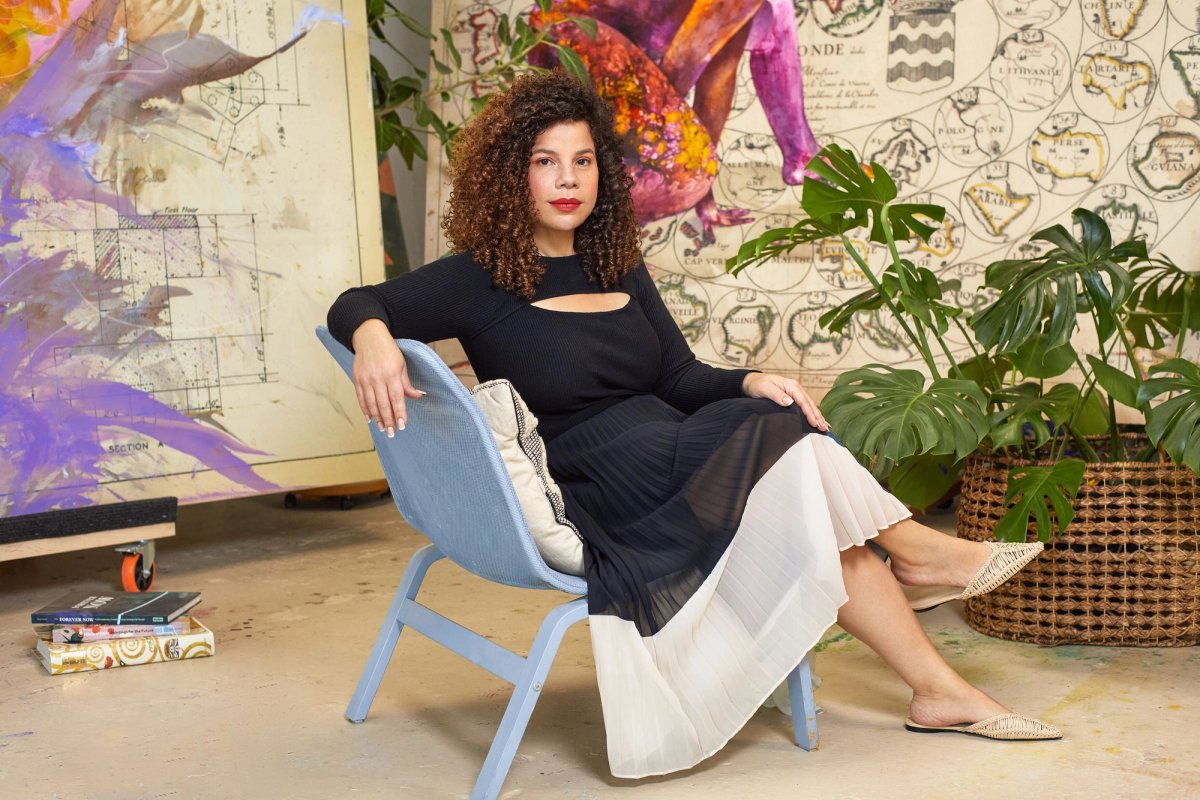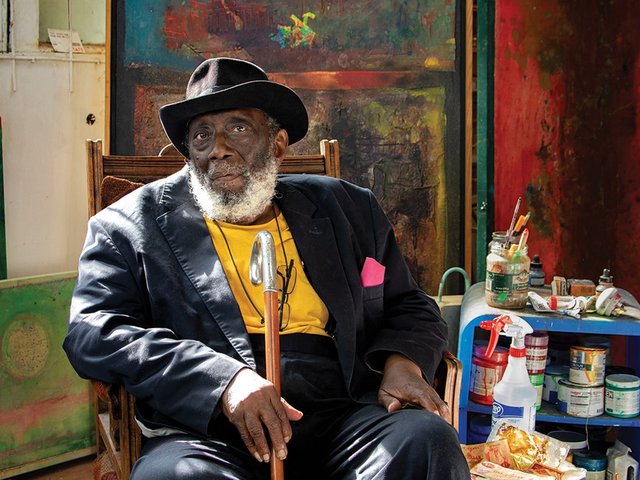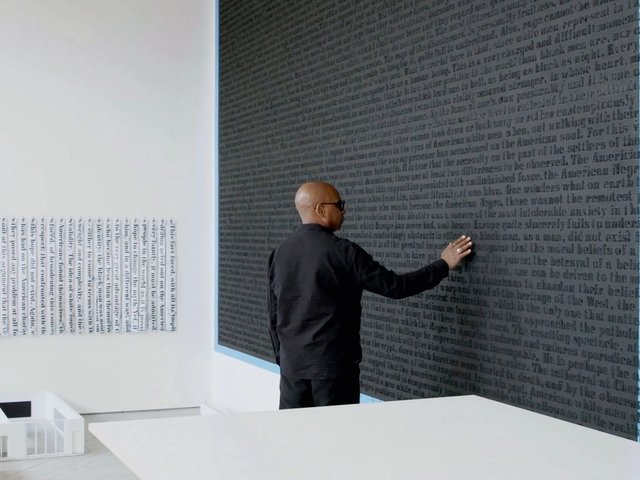Firelei Báez has been busy.
The artist’s first solo exhibition at Hauser & Wirth, the international mega-gallery that started representing her last year, brings her signature phantasmagoric eye and flare for storytelling to Downtown Los Angeles. Then there is her eponymous traveling museum show, which opened on e November at the Vancouver Art Gallery, hot on the heels of her German institutional debut, Trust Memory Over History, which closed on 13 October at Kunstmuseum Wolfsburg. Last summer also included her first UK solo turn and first North American survey, at South London Gallery and the Institute of Contemporary Art Boston, respectively.
Suffice to say, Báez has arrived, which means that her surreal, sensitive interventions in dominant postcolonial narratives have officially hit the world stage. This is appropriate, since her work often uses the world as its stage, sometimes literally—figures bristling with feminine, mucosal urgency emerge from backgrounds of 18th-century maps or travelogues, each chimera an agent of resistance against the oppression that Afro Carribean diasporic cultures have survived.
Báez was born in the Dominican Republic to a Dominican mother and a Haitian father before relocating to Miami as a child. Growing up, she was keenly aware of the geopolitical and ethnic tensions that shaped her heritage, and she found solace in the writing of Arturo Alfonso Schomburg, the renowned Puerto Rican historian and activist of the Harlem Renaissance era. His contributions to the canon centred Báez’s ancestral history, sparking a materialist engagement in the archive that would come to undergird her work.
Art gave her ownership of the stories projected upon her lived experience by white supremacy. Her interest in reclamation and re-imagination inspired her to study art at Cooper Union and Hunter College in New York City, where she is still based. In 2008, during a residency at the Skowhegan School of Painting and Sculpture, her painterly abstractions began to include folkloric creatures like ciguapas, female tricksters of Dominican myth that have since beceme a signature trope in her work.
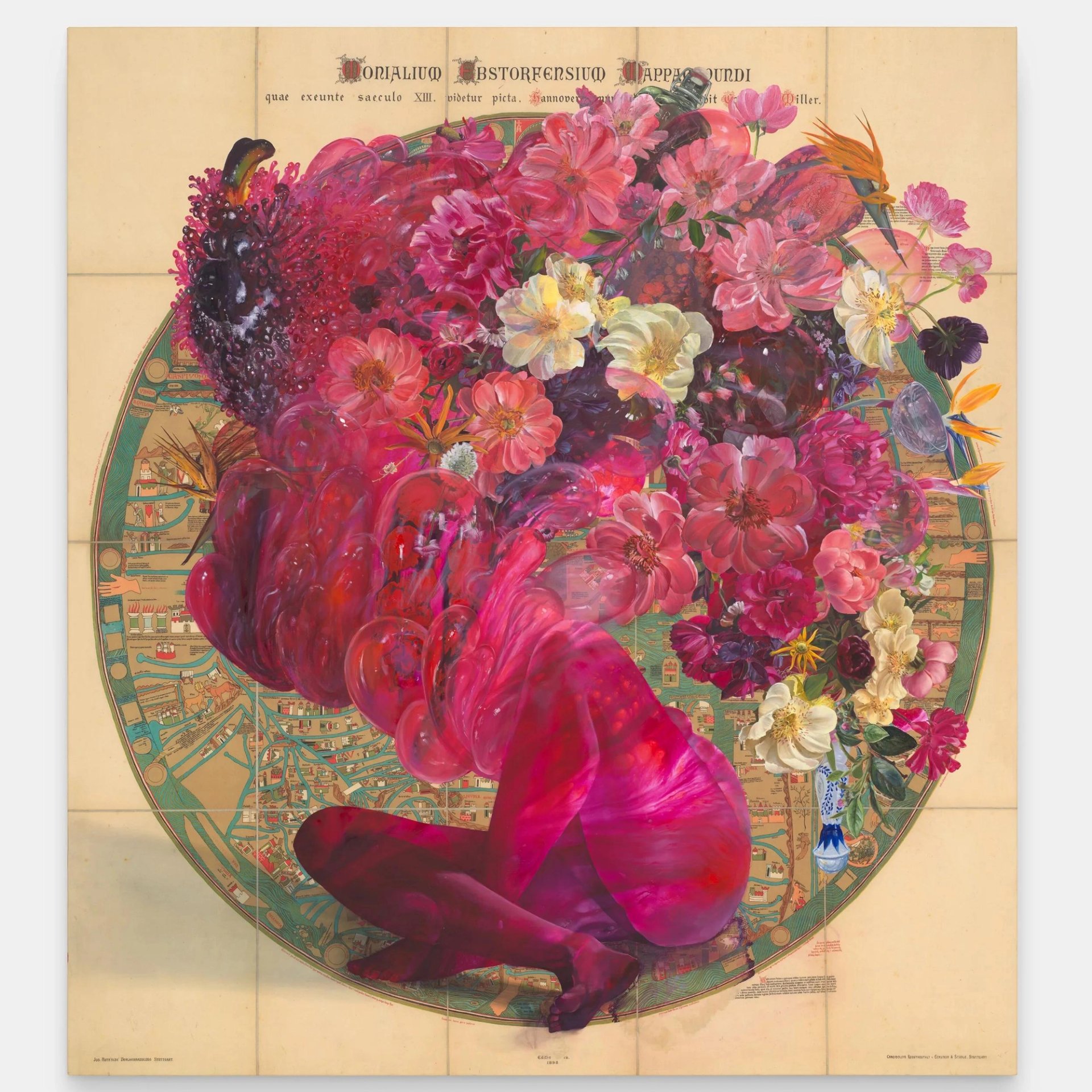
Firelei Báez, Anacaona (destroy the beauty that has injured me), 2024 Courtesy the artist and Hauser & Wirth
Báez’s blooming, atemporal tableaux sit at the intersection of flora and fauna, up-ending the violent fiction of a “conquered” landscape through fantastical displays of wildness. Motifs like tignons, the colonially-mandated head coverings required of non-white women in 18th-century New Orleans, or the image of Sans-Souci, the once-glorious palace of Hatian revolutionary Henri Christophe, help populate her edgeless visual universe, operating as totems against easy definition or singular legibility. Báez has earned the 2021 Philip Guston Rome Prize, the 2019 Soros Arts Fellowship and the 2017 Future Generation Art Prize.
Her current exhibition at Hauser & Wirth in Downtown Los Angeles, The fact that it amazes me does not mean I relinquish it, borrows its title from Martinician philosopher Édouard Glissant, a leading member of the Négritude movement, a literary challenge to the presumed cultural supremacy of white aesthetics. Drawing from Glissant’s text Poetics of Relation from 1990, Báez uses furious pulchritude and self-obfuscating composition to explore the theorist’s concept of “opacity”, a political refusal of legibility to the white gaze.
The Art Newspaper recently spoke with Báez about books, bronze and, of course, beauty.
The Art Newspaper: You have so many shows happening concurrently! Do you have a system for how you keep each visual narrative straight?
Firelei Báez: It's a lot. This year is like turducken, but we count the blessings and dance while there's music. Of course, I definitely want to do it all. I have terrible time blindness, so if there’s an opening in March, I’m working on that for months in advance—it’s a year's commitment, so it might mean that we might be installing in February, and if you had another opening in February, that means like hopscotching from one place to another to install.
The most important part of managing everything is collaborating with a curator, because a lot of times they'll see something and then help you ground it in the budget. It’s funny how many times the budget will dictate vision. You'd think that would be a constricting way, but it forces you to be more creative. Like for the South London Gallery, that was a not-for-profit with 23 young curators, all with a different vision, but with varying levels of experience. It was like Project Runway more than anything, where it’s like,”You have two seconds and two shoestrings, go! Make magic!” So it forced us to do that because the budget was so low and there were restrictions, and whatever was made there was out of our shared creativity. So many times in different spaces, the creativity of the curator and what I would love to do in that space meets the boundary of the budget and then we have to create something based on that. When I was at Skowhegan, they had all these interviews that were recorded from different artists, and I listened to Adrian Piper give a beautiful lecture on conceptual art that ultimately cinched on how artists are boundless, the only real limit is the budget.
Technically, our minds are capable of anything, and that restriction is the one grounding fact that gives us guidelines. For a lot of the compositions, I'll get a flash vision of what I want to do and the goal is to always get as close as possible to that vision but then everything around it will determine how it's actually completely manifested, down to the humidity in the air or how sunny or the day is.
Do you find that audiences are responding differently to your work in different parts of the world?
I'm purposely opening the work so that it's able to function like a Rorschach. It's hyper-specific to a geography, but also hyper-specific to viewer experience. I'm always so excited when someone from Iceland, for instance, who has a shared history of colonisation or environmental change or of migration that we would have in the Caribbean, can have a crossroads experience. It’s something I couldn't have dictated. There's this beautiful essay by a writer from Greenland (Katrine Rasmussen Kielsen) in the Louisiana Museum Denmark catalogue for Trust Memory Over History. Greenland was a colony of Denmark, so her essay is one of the things that I'm really happy to have been lucky enough to experience, because it's something I couldn't have dictated as a person living in New York. In New York, we feel like we're the centre of the world and we have everything and anything your heart desires, but we forget that we can also be a bit insular and provincial when we forget, when we don't access these different spaces.
Returning to the Hauser & Wirth show and your study of Glissant’s theory of “opacity”, I wondered if you could talk about the tension between opacity and beauty in the work.
There are active antonyms working all the time and depending on where you're coming from, what cultural constructs you're working with, they might seem like impossibilities or absolute potentials. Growing up in the Caribbean, you're constantly surrounded by antonyms that are not necessarily end-of-line, but are questions to make you construct differently and newly every day. Beauty as a form is something that is extremely subjective. It's very culturally determined. I am hoping that in the process of viewing, you're asking yourself how your sense of beauty differs from someone else, and what are the bridges in between. That bridge is so fruitful for me, that you basically have a means of navigating the unknown and not being afraid of it, but feeling like you're one and enmeshed with the other in a way that doesn't necessarily require absolute mirroring or absolute twinning of self, which is what is really sad in contemporary politics, even, to think of how we deal with migration, economics and all these different things in a way that is so isolating.
There's this wonderful essay by Gilles Deleuze and Félix Guattari (from A Thousand Plateaus Capitalism and Schizophrenia), who themselves are very influenced by the image of the orchid. The orchid appears in a lot of the Ciguapa figures, because it was an orchid that mimicked not just the look but the pheromones emitted by a beetle. While these theorists were geeking out about the frenzied lovemaking between a beetle and the orchid, how these two creatures propagating each other are so completely different, I’m thinking, “What about the female beetle?” So much of what we see now, environmentally and politically, are remnants of our rapacious isolation of the human self. That for me is true beauty, when we can go beyond the limit.
How do you think of your work’s relationship with the viewer?
Materiality for me is the way to navigate the presence of a viewer to the work. And as inviting as an illusionistic painting can be, it is like trompe l'oeil, the things that look like real things in the world are just meant to get you closer to question. The thing that's meant to be more factual or to get you anchored in the moment and remind you that you are a being in the presence another being, of another matter, is the thing that starts all the paintings, which is a pour in the ground.
These pours are very determined by the spaces that they're made in. Two circular paintings in the Hauser & Wirth show had paint that was poured just ten feet apart from each other, but the floor on one side had more absorbent ground, and the other one was more regular concrete, so the paint dried entirely differently on each. Same building, ten feet apart, and the environment really dictates what the paint can do. In one it looks like puckered skin, and you're seeing the pores of a body; the other one is like plumes of soft color that go off in one direction. Nature does things that are way beyond our control and are just gorgeous.
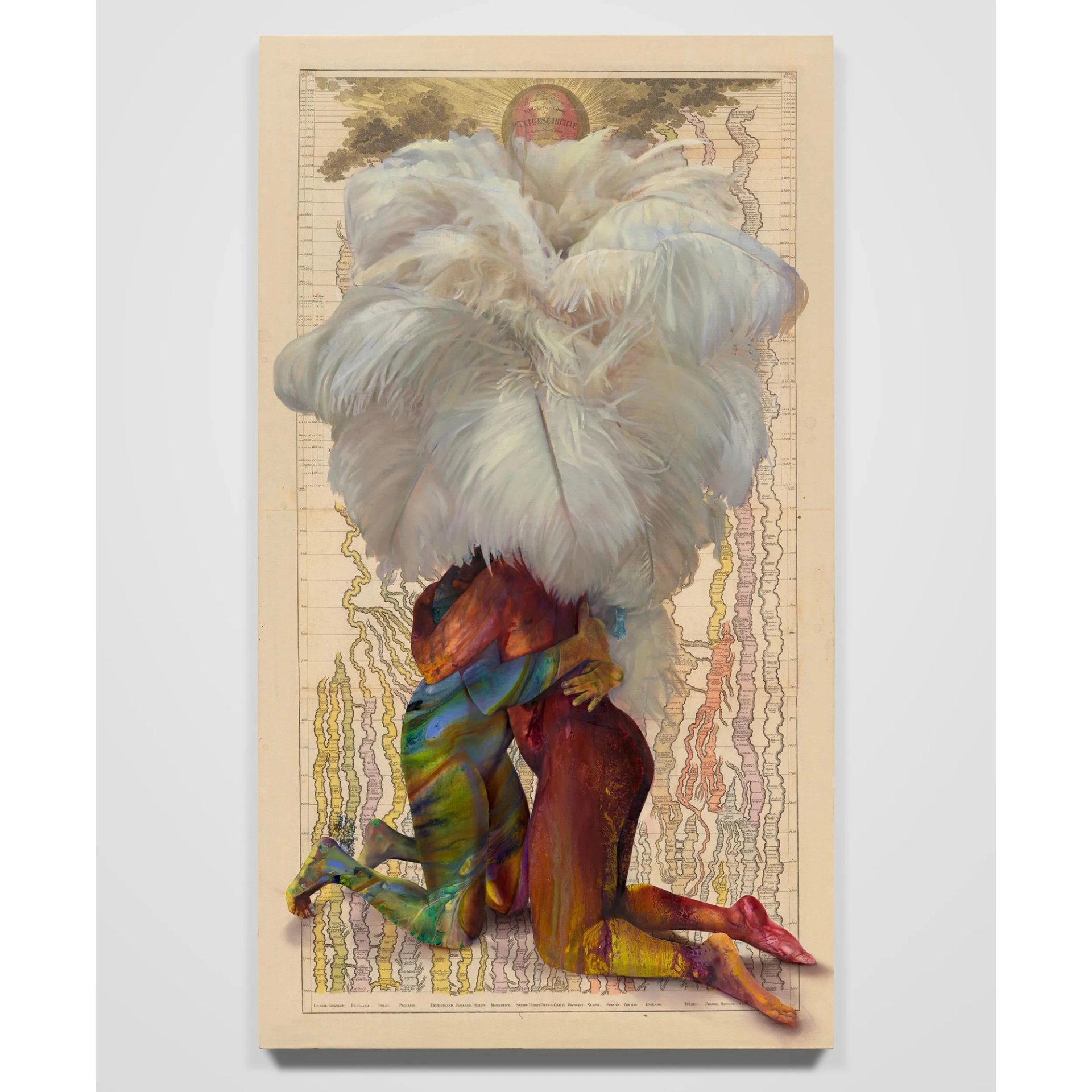
Firelei Báez, Untitled (the river of time), 2024 Courtesy the artist and Hauser & Wirth
How do you decide what ideas become sculptures as opposed to what stays a painting?
For the Hauser & Wirth show, [I made] my first three-dimensional thing. There are three in the set, and I'll be showing the final two in my show in spring 2026 with the gallery. For those, if it's cast or if it's made in an architectural scale, those require not just myself in the studio but whole teams. You need architects! Even for the bronze, you need to figure out how to make sure it won’t tip over if it’s two tons. There's a lot more than just my hand and clay. There are all these different factors.
So I'll have the vision and the material constraints, the codes for the building will be a constraint. There will be all these different things that I have to negotiate. For instance, the bronze that is at Hauser & Wirth was inspired by an early Ciguapa painting I had of a figure crouching, almost doing a duck walk. But that gesture is impossible in bronze at two tons. It will cause a hinge that will be unstable. So I had to make an extended gesture. That meant working with a dancer or a real-life person.
There's something that happens when you cast a body, it takes so long for the material to dry around the body that the body has to relax, so you'll never get a true tension of a flexed muscle. If you want to have something that suggests flexed muscle, you have to model it yourself, which meant that I had to work with several dancers in different poses to try to get it to be right. Otherwise you get something that's very passive and that doesn't suggest movement. I wanted it to feel like a storm or a figure bracing against a storm. That meant figuring out how to do that when every small gesture is 75 pounds, when it has to be absolutely stable. You need a triangle that is broad enough to stabilise that top. I had to relearn the limits of that form and that material to express what I wanted.
In painting, you can do whatever you want. Anything can defy gravity. I realised that the image I had painted would be impossible in bronze. I'd have to go into some other material. If I wanted to continue in bronze, I had to re-learn. That's the toughest part. You have to essentially re-teach yourself a language each time you go into a new medium. And then know how to do that with other people. But it is fun!
Your work is heavily researched. What is your relationship with the archive and how do you sustain it?
It's a process of following your curiosity and knowing that there are so many resources. The title of the Hauser & Wirth show, the line from “Opacity”, is almost a parallel to our engagement with the internet or with any virtual space where you have to consent to data capture. You access this portal, but you have to essentially say you accept or deny this relinquishing of yourself. And that's another tool of opacity, that you basically don't have to relinquish yourself. Just because there are parts of yourself that are being quantified and are being monetised, it doesn't mean that you relinquish them.
Part of the research for the Downtown Los Angeles show was this idea of consent or denial and bodily autonomy, and trying to go back as far as I could through documents on what are the foundations of our contemporary understanding of that dynamic, asking whether or not we have to give ourselves up to gain knowledge. I went back to what would be a common ground in the West, the Second Crusade. I made this feather painting that is overlaid onto this ground of all the different kingdoms from the East to West, but essentially it was just the extent of the Ottoman Empire.
There is an idea that contemporary capitalism would not exist as it is if it weren't for the Crusades that followed the Ottoman Empire and the plague, for instance. things that activated going into the New World, the Renaissance, etc. Then the transatlantic slave trade and colonisation dictated our nine-to-five hours. The conscription of bodies and enslavement in the Caribbean dictated our job hours now.
A lot of the diagrams were just me geeking out and unpacking questions and answers, seeking out tools for engagement—for freedom, really. One of my favourite archives is the David Ramsay archive at the Library of Congress. There’s all this free imagery—anything from an ad for a bar of soap in 1820 to a game teaching colonisation to the French prince are all available, and you can just start unpacking them.
- Firelei Báez, until 16 March 2025 Vancouver Art Gallery, Canada
- Firelei Báez: The Fact that it Amazes Me Does Not Mean I Relinquish It, until 5 January 2025, Hauser & Wirth, Downtown Los Angeles


